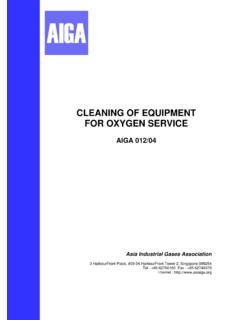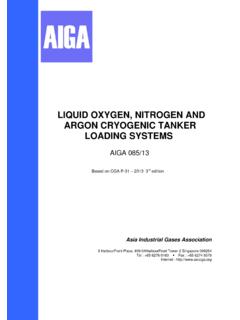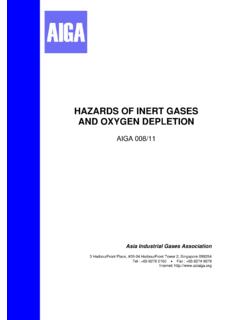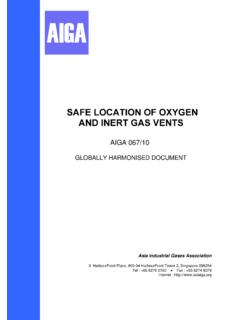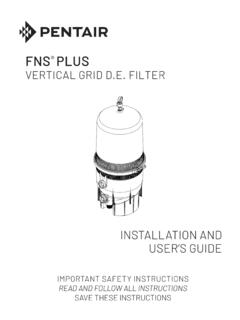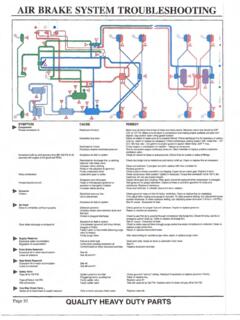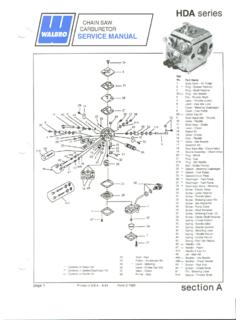Transcription of STANDARD FOR HYDROGEN PIPING SYSTEMS AT USER …
1 STANDARD FOR HYDROGEN PIPING SYSTEMS AT USER LOCATIONS AIGA 087/14 Based on CGA 2012 Fifth Edition Asia Industrial Gases Association 3 HarbourFront Place, #09-04 HarbourFront Tower 2, Singapore 099254 Tel : +65 62760160 Internet : Reproduced with permission from Compressed Gas Association. All rights reserved. ASIA INDUSTRIAL GASES ASSOCIATION 3 HarbourFront Place #09-04 HarbourFront Tower 2 Singapore 099254 Internet: AIGA 087/14 STANDARD FOR HYDROGEN PIPING SYSTEMS AT USER LOCATIONS Disclaimer All publications of AIGA or bearing AIGA s name contain information, including Codes of Practice, safety procedures and other technical information that were obtained from sources believed by AIGA to be reliable and/ or based on technical information and experience currently available from members of AIGA and others at the date of the publication.
2 As such, we do not make any rep-resentation or warranty nor accept any liability as to the accuracy, completeness or correctness of the information contained in these publications. While AIGA recommends that its members refer to or use its publications, such reference to or use thereof by its members or third parties is purely voluntary and not binding. AIGA or its members make no guarantee of the results and assume no liability or responsibility in connection with the reference to or use of information or suggestions contained in AIGA s publications. AIGA has no control whatsoever as regards, performance or non performance, misinterpretation, proper or improper use of any information or suggestions contained in AIGA s publications by any person or entity (including AIGA members) and AIGA expressly disclaims any liability in connection thereto. AIGA s publications are subject to periodic review and users are cautioned to obtain the latest edition.
3 NOTE Technical changes from the previous edition are underlined. PAGE ii AIGA 087/14 Contents Page 1 Introduction .. 1 2 Scope .. 1 3 PIPING system criteria .. 1 Design criteria .. 1 PIPING materials .. 2 System components .. 3 Electrical equipment .. 5 4 Cleaning .. 5 General .. 5 Cleaning procedures .. 6 Inspection tests for cleanliness requirements .. 6 5 Installation .. 7 General .. 7 Aboveground installation .. 10 Underground installation .. 10 Electrical installation .. 11 Electrical grounding and bonding .. 11 6 System startup .. 10 Inspection .. 11 Testing .. 11 Purging .. 12 Operation .. 12 7 Maintenance and repair .. 12 Inspection .. 12 Grounding system .. 12 Maintenance .. 12 Records .. 12 8 References .. 13 Figures Figure 1 Typical pressure relief device installation uninsulated cold HYDROGEN PIPING .
4 3 Figure 2 Typical gaseous HYDROGEN PIPING SYSTEMS .. 9 AIGA 087/14 PAGE 1 1 Introduction This STANDARD is one of a series prepared by the Compressed Gas Association, Inc. (CGA) to provide information on the transportation, handling, and storage of HYDROGEN . The industrial gases companies have engaged through the International Harmonization Council (IHC), comprised of the Asia Industrial Gases Association (AIGA), Compressed Gas Association (CGA), European Industrial Gases Association (EIGA), and Japan Industrial and Medical Gases Association (JIMGA), in a process of developing harmonized safety practices and this publication is one of them. Furthermore, to the extent that they exist, national laws supersede the suggested practices listed in this publication.
5 It should not be assumed that every local STANDARD , test, safety procedure, or method is contained in these recommendations or that abnormal or unusual circumstances may not warrant additional requirements or procedures. 2 Scope This STANDARD describes the specifications and general principles recommended for PIPING SYSTEMS for gaseous (Type I) or liquid (Type II) HYDROGEN . The STANDARD addresses both low and high pressure HYDROGEN PIPING SYSTEMS onsite from the point where HYDROGEN enters the distribution PIPING (the battery limits of the HYDROGEN storage system) to the point of use. For the purposes of this STANDARD , high pressure is defined as gaseous HYDROGEN at service pressures equal to or greater than 3000 psig (20 680 kPa).1, 2 The information in this STANDARD is general in nature and is intended for designers, fabricators, installers, users, and maintainers of HYDROGEN PIPING SYSTEMS as well as for safety personnel, fire departments, building inspectors, and emergency personnel.
6 Basic information on the properties, storage, and handling of HYDROGEN can be found in CGA G-5, HYDROGEN ; CGA , Commodity Specification for HYDROGEN ; National Fire Protection Association (NFPA) 52, Vehicular Gaseous Fuel SYSTEMS Code; NFPA 55, Compressed Gases and Cryogenic Fluids Code; and the CGA Handbook of Compressed Gases [2, 3, 4, 5, 6]. 3 PIPING system criteria Design criteria HYDROGEN PIPING SYSTEMS should be designed in accordance with the American Society of Mechanical Engineers (ASME) , HYDROGEN PIPING and Pipelines, other applicable codes and regulations, and the special requirements for HYDROGEN service [7]. Single wall PIPING is used for gaseous HYDROGEN service and for liquid HYDROGEN service when thermal insulation is not required. Vacuum-insulated PIPING is recommended for liquid HYDROGEN service. PIPING SYSTEMS shall be designed to take into consideration the following: a) fully depressurize the system for maintenance (for example, to avoid pressure trapped behind check valves ); b) isolate the system for maintenance, (for example, double block and bleed , positive isolation); and c) purge the system with an inert gas before maintenance and with HYDROGEN after maintenance.
7 PIPING , tubing, fittings, valves , accessory equipment, gaskets, and thread sealants shall be suitable for HYDROGEN service at the pressures and temperatures encountered and shall maintain their integrity under elevated temperatures during fire conditions (see ). Selection of PIPING joints shall consider the potential for leaks, mechanical strength, material, and fire safety acceptability. The PIPING and accessory equipment shall be suitably cleaned for the level of service for which the HYDROGEN is intended. 1 kPa shall indicate gauge pressure unless otherwise noted as (kPa, abs) for absolute pressure or (kPa, differential) for dif-ferential pressure. All kPa values are rounded off per CGA P-11, Metric Practice Guide for the Compressed Gas Industry [1]. 2 References are shown by bracketed numbers and are listed in order of appearance in the reference section.
8 PAGE 2 AIGA 087/14 All electrical equipment and electrical grounding apparatus shall comply with NFPA 70, National Electrical Code , or Canadian Standards Association (CSA) , Canadian Electrical Code, Part I, as applicable [8, 9]. The PIPING system shall be bonded and grounded to dissipate static electricity. PIPING materials Metal Material specifications and thickness requirements for PIPING and tubing shall conform to ASME [7]. PIPING , tubing, valves , and fittings for operating temperatures less than 20 F ( 29 C) shall be fabricated from materials listed in ASME for the operating temperature or shall meet impact test requirements when tested at the minimum operating temperature the system is subjected to when in service [7].
9 Many engineering alloys experience a degradation of properties when used in high pressure HYDROGEN service. The generic term for this is HYDROGEN embrittlement. The effects can range from a reduction in tensile strength and ductility to a marked increase in the rate of fatigue crack growth. Elevated temperatures also can be problematic, promoting HYDROGEN attack in carbon and low-alloy steels. AIGA 033, HYDROGEN Pipeline SYSTEMS , provides a more detailed discussion of HYDROGEN embrittlement and attack [10]. Austenitic (300 series) stainless steels meeting the temperature limits of ASME are recommended for liquid and gaseous HYDROGEN product PIPING , tubing, valves , and fittings [7]. The most stable grade is Type 316/316L. Type 316/316L is relatively immune to HYDROGEN embrittlement when exposed to high pressure HYDROGEN and is preferred over other grades such as Type 304L and Type 321.
10 When available, austenitic stainless steels should be used in the annealed condition. Carbon steel usually is limited to gas service at operating temperatures equal to or greater than 20 F ( 29 C). Carbon steels meeting the temperature limits of ASME may be used for gaseous HYDROGEN product PIPING , tubing, valves , and fittings [7]. For high pressure applications, carbon steel shall be used with caution. Carbon steels with high-carbon content and high-strength, low-alloy carbon steels are susceptible to embrittlement and crack propagation. The use of carbon or alloy steels requires control of tensile strength, heat treatment, microstructure, and surface finish as well as initial and periodic examination for inclusions and crack-like defects when in cyclic service. AIGA 033 and EIGA Doc 100/03, HYDROGEN cylinders and transport vessels, are examples of guidelines for the allowable composition of various alloy steels for HYDROGEN service [10, 11].
